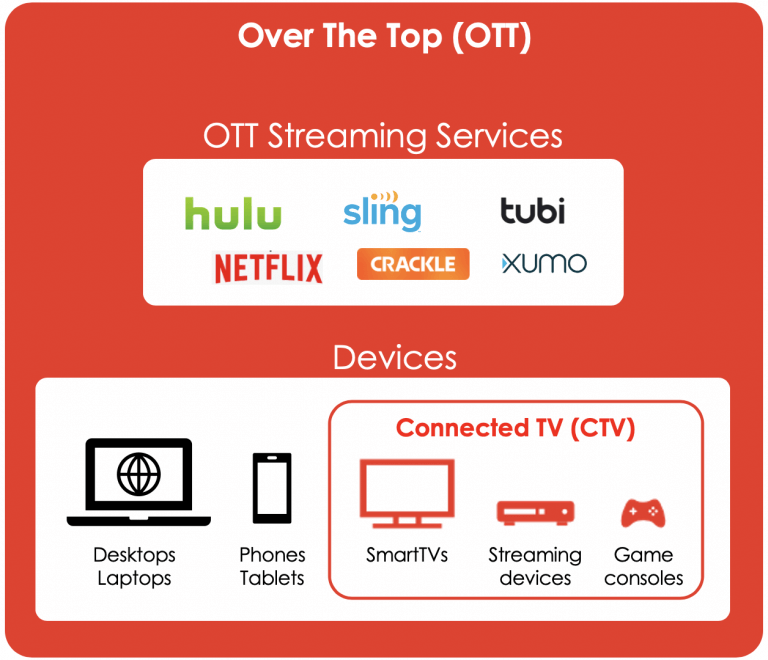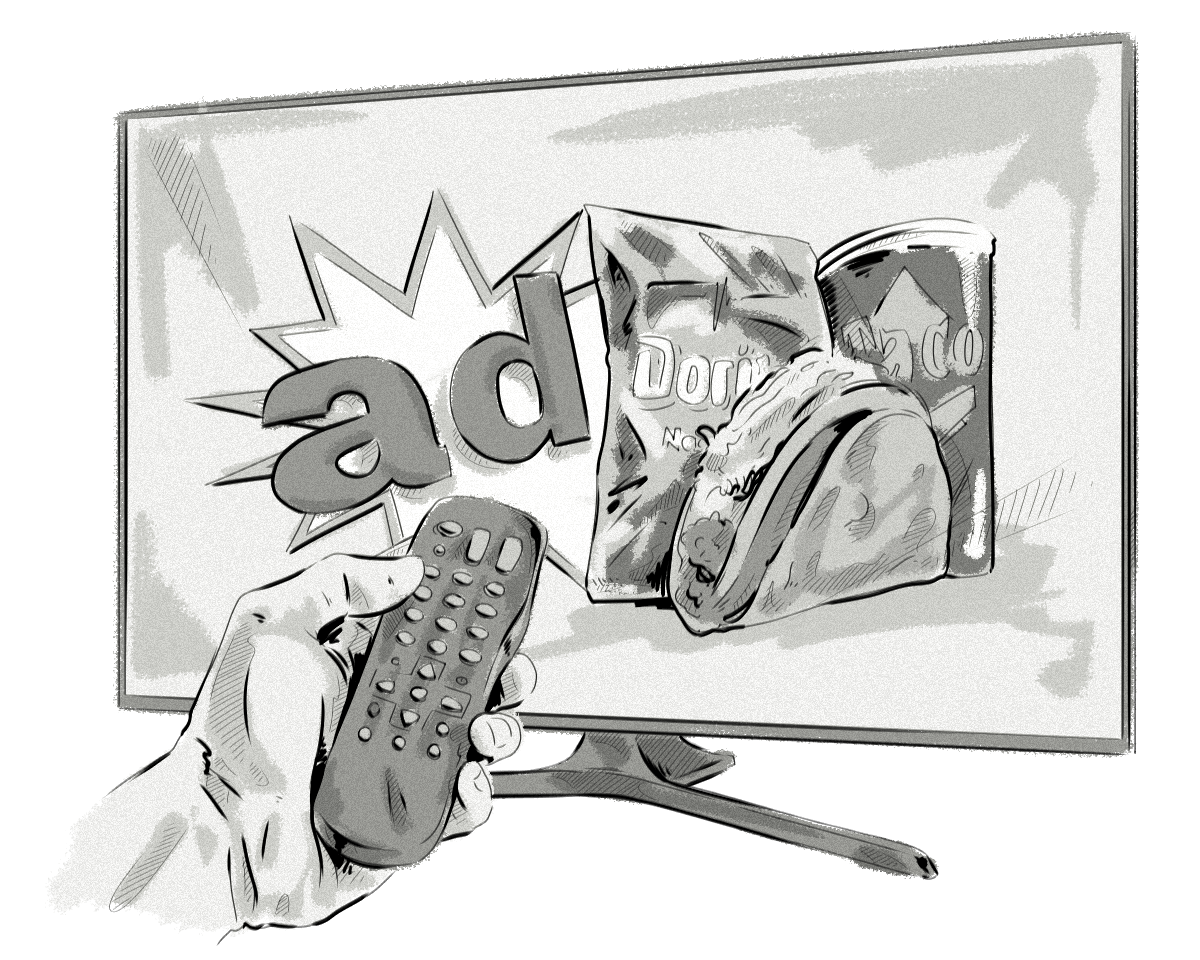Cable television is in decline, seriously losing to streaming media in terms of convenience and reach. Video ad views on OTT (over-the-top) devices grew 63% year over year in Q3 2016, and the trend is expected to continue.
Consequently, traditional TV ads can now offer a mere fraction of their original reach and appeal. Streaming content is the new television, and with OTT advertising, it may also be the death knell for traditional TV commercials.
Source: FreeWheel Q3 2016 Video Monetization Report
What is OTT Advertising?
The term over-the-top basically refers to the service used to stream digital content to a TV or similar device. The group of devices commonly classified as OTT include:
- Streaming boxes (Apple TV, Amazon Fire TV, Android TV, Samsung Allshare Cast)
- HDMI sticks (Chromecast, Roku, Amazon Fire TV Stick)
- Smart TV (through in-TV apps like Netflix or HBO Go)
- Game consoles
- DVR set-top boxes
- Internet-enabled smart blu-ray/DVD players
OTT advertising is much like advertising on TV, but delivered through streaming media on OTT platforms. The technology is expected to vastly improve in coming months and to offer marketers the best of both worlds—the benefits of programmatic, as well as the growing reach of streaming services. With OTT ad revenue set to increase from 45% to 60% over the next decade, AdTech pioneers and early adopters of OTT advertising will reap its benefits in the near future.
What’s the Difference Between OTT and Connected TV (CTV)
In the past, describing the difference between OTT and CTV has been a matter of opinion. Luckily, the IAB Tech Lab have created some concrete definitions for these two terms.
OTT: Content that is streaming via popular services like Netflix and Hulu.
CTV: Video that is delivered via an Internet connection on a big screen, e.g. a smart TV. Other Internet-enabled devices like Roku, Fire stick, Apple TV, and game consoles also fall into this category.

Wait, I Don’t Want Ads on Netflix!
Hold on—premium subscriptions are and will likely remain ad-free, so you can rest assured Netflix is safe. OTT advertising will mostly be limited to free-to-watch, post-cable news platforms like Crackle, Yahoo View, Cheddar, Newsy, and The Young Turks.
However, for those after Netflix-like content (series, movies, and documentaries), there are still dozens of channels like Tubi.TV or Roku Channel, and many other country-specific services; they offer Hollywood hits, all free to watch (typically ad-supported) for registered users.
The growth and potential of OTT advertising was highlighted recently with reports that Hulu’s ad revenue surpassed $1 billion for the first time, and Roku’s ad business doubled in 2018.
There are already many niche networks competing for advertising dollars, and there will certainly be more channels to come as the technology matures.
Such a strategy can allow producers of OTT devices and platforms to also cater to non-paying audiences, and by leveraging the platform’s advertising potential, significantly reduce the cost of their devices and help keep some of the content free to watch.
Why is OTT Popular Now and What Are Its Benefits?
TV viewers tend to spend increasing amounts of time watching video content via smart, internet-enabled TVs and OTT video services. OTT has become a very attractive territory for a couple of reasons.
First and foremost, although its advertising potential hasn’t fully been explored, it may offer a lot of benefits over traditional online display advertising.
We Can Help You Build an OTT Advertising Platform
Our AdTech development teams can work with you to design, build, and maintain a custom-built OTT advertising platform for any programmatic advertising channel.
Land of Opportunity, Land of Unknown
The OTT territory is very fragmented, but at the same time, still uncharted and completely unspoiled. At least for now, there’s no ad fraud because the streaming platforms are typically closed, controlled systems.
People watching media on OTT devices can’t simply close the window and skip ads, jump to another browser tab, or install an adblocker to get rid of the ads altogether.
On the other hand, a lot of industry-specific metrics like click-through rate (CTR) or completion rates prove completely irrelevant for OTT. After all, you can’t click the TV screen, and can rarely interact with the ads in any way. At the same time, video completion rates are incredibly high for OTT platforms, completely dwarfing the figures for in-browser video ads.
Also, while there are certain web-, video-, and mobile-advertising guidelines proposed by the Interactive Advertising Bureau (IAB), there are currently no such standards strictly for OTT-advertising videos.
OTT is the Only Viable Alternative to Traditional TV Commercials
The grand exodus from traditional television has begun for good. We are frequently referring to the cable TV audience as nevers, cord cutters, or cord shavers.
- Nevers are people for whom TV has never been an important medium. They never signed up for subscription television or paid for premium channels. They may, however, access media through streaming services like Netflix, Hulu, Amazon Prime, or HBO Go.
- Cord shavers are people who regularly pay for subscription television but have, for various reasons, decided to cut down on their plans. They’ve kept some of their channels, but are increasingly switching to streaming services.
- Cord cutters are those who have completely cancelled their subscription plans, and may have switched to streaming services.
It seems that OTT advertising may ultimately be the only way for TV advertisers to reach the above groups and recoup some of the revenue lost to video streaming.
A recent survey by Pew Research Center indicates that 61% of Americans ages 18–29 watch television through streaming services today, while only 31% of them mostly use a cable or satellite subscription. A mere 5% mainly watch TV through a digital antenna. For people ages 50–64, these numbers are 10%, 70%, and 15% respectively.
Bigger Screen, Wider Audience
Advertising through OTT grants access to the living room, where families spend time together, often independent of what’s on at the moment. Also, unlike in the browser screen, OTT video ads tend to be displayed full-screen without proper controls to either minimize or skip them.
The audience for OTT media is much more diverse, and not limited to tech-savvy young people like in many other platforms. Also, OTT ads can be targeted at the household level.
Best of Both Worlds
OTT advertising offers some of the benefits of advertising technology that marketers have used in online ads for years.
There is targeting, dynamic ad insertion, and advanced analytics. While most of these technologies have yet to be fully implemented in OTT, it is certain that there will be easier methods to access inventory in the future.
Unlike traditional TV commercials, OTT may offer much shorter ads, but at the same time make them more personalized. This will be possible through targeting capabilities absent in traditional TV with geolocation, demographic data, and device information.
How Are OTT Ads Delivered?
Delivery of OTT ads requires consideration of how the streaming platform communicates with OTT devices—for example, via Video Ad Serving Template (VAST) or Video Player-Ad Interface Definition (VPAID) tags—and the ad-insertion method, whether they will be served client side (CSAI) or server side (SSAI). The general delivery process of OTT ads is as follows:
1. An audience is created: An OTT audience is created based on the platform’s subscription data, but in some cases, they could also be enriched with additional household information. This can include first- and third-party data—the users’ preferred categories of shows or specific shows watched on the platform, for example.
2. The campaign is pushed: Audience matching starts. The platform will match the audience to the specific TV’s subscriber lists on various OTT platforms. The ads are pushed, downloaded, and buffered by the OTT devices.
3. Ads are displayed via OTT platforms: This is where, depending on the platform, OTT devices are communicated with using VAST or VPAID tags (more about that below).
4. Reporting: The OTT operator sends back ad-exposure results after the campaign and the platform generates the reports for the advertiser. Typically, the campaigns are enriched with the first- and third-party data.
OTT Ad-Insertion Methods
CSAI
Client-side ad insertion (CSAI) is the legacy method, whereby ads are loaded within the OTT box itself before they get displayed to the viewer. This method does not provide an effective way for displaying ads to viewers, and is susceptible to ad blockers, but is currently the leading method in OTT devices within the advertising industry.

Client-side ad insertion (image adapted from theoplayer.com)
SSAI and Stitching
In server-side ad-insertion (SSAI) content delivery, the ads are served as a seamless stream. The process creates, in real time, a mix of ads and core content streamed to the client device frame-by-frame. Because ad blockers have no possibility to discriminate which frames are ads and which are not, SSAI is a very effective remedy for ad-blocking software.

Server-side ad insertion (image adapted from theoplayer.com)
SSAI allows a seamless video experience even for live feeds. It “stitches” the content together with ads, thus eliminating the bothersome pauses between the actual video and ads. If clickable ads or viewability measurements are needed (via the support of VPAID tags), those capabilities can be added after on the client side; however, this requires some additional development on the OTT producer’s end.
While most producers don’t consider those capabilities important, particular OTT platforms work hard and try to give their clients more measurement and interactivity with built-in support for VPAID tags.
Stitching, made possible by VPAID tags, is a step forward from a viewer’s perspective, but it also imposes some limitations for the advertiser. Most popular ad technologies are still built upon client-side methodologies today.
Advantages of Server-Side Ad Insertion in OTT
As mentioned above, OTT ads can be served via a process known as client-side ad insertion (CSAI) or, ideally, from the same place as the video itself via server-side ad insertion (SSAI)—they are not served from a third-party platform like videos on web pages are. The latter method offers a couple of advantages:
- The problems of ad fraud and ad blockers are practically eliminated in SSAI OTT ads.
- SSAI is also known under the term “ad stitching”. There are no latency issues connected with sending out VAST requests, waiting for a response, loading an asset, and then resuming playback. This usually happens in the case of client-side ad insertion, when viewers may experience video buffering, freezing, and blocking.
- Eliminates problems associated with going from playback of one asset to another, such as spinning wheels, resolution changes, loss of playback buffer, etc. Bottom line: server-side ad insertion offers a more seamless experience for the viewer.
- Easier development. Implementing client-side ad insertion requires developers to use many software-development kits on the client devices.
- Increased consistency and reliability of SSAI ads increases overall quality of an OTT platform and offers better engagement of viewers.
Tags Used for Communicating With OTT Devices
VAST Tags
VAST tags provide instructions for the player about how to handle a video ad—how it should show up in the player, how long it should display, if the user can skip it, where the ad is located (the ad server information), etc.
VPAID Tags
Video Player-Ad Interface Definition (VPAID) tags are an improvement of VAST tags, which makes ads interactive and adds viewability measurement. However, as mentioned above, these tags don’t support stitching, which entails bypassing more than half of all video pre-rolls served in Europe.
VPAID tags are relied upon to measure the viewability and verification mentioned above, and in some cases, offer interactivity, which has led some agencies and advertisers to prefer VPAID tags over VAST tags.
Challenges of OTT Advertising
As evidenced in the previous paragraphs, OTT advertising can offer a number of benefits over traditional TV advertising. However, there is still a number of technological challenges to overcome before OTT advertising can gain traction for good:
- For now, much of the smart TV and OTT inventory available programmatically can only be accessed directly, either from smart TV manufacturers or OTT service providers.
- Currently, there is no support for third-party ad serving and measurement.
- OTT advertising is still a very fragmented territory, lacking industry-wide standards and guidelines.
- Most OTT devices lack certain capabilities compared to a web browser. This means there are no cookies and no flash support, which limits an advertisers ability to properly target viewers and attribute conversions. Also, due to the closed nature of most OTT devices, digital ads and third-party tags from other platforms may be incompatible, leading to measurement discrepancies.
- VPAID is an extension of VAST. It was introduced to enable rich ad experiences (interactive media ads, for example), and detailed analytics for video ads. However, due to the somewhat limited character of OTT platforms, there is currently no possibility of implementing executable ad units. Communication between ad servers and the devices can only be based on VAST advertising tags, a format developed by the IAB for standardization of serving video ads.
The Future of OTT
Despite its challenges, OTT advertising is loaded with numerous opportunities. IAB envisions two iterations of OTT capabilities, which roughly follow the development of programmatic that we witnessed in the past two decades.
In its first and current iteration, brands can buy directly from OTT content providers, using viewing information and the program environment as a proxy for product interest. Then, the campaigns themselves are executed programmatically. Since most streaming services are based on paid subscriptions, publishers know exactly where the audience lives. Free OTT services that don’t have a database of paying subscribers rely more on external data sources such as Google’s ad-targeting and matching services.
In its next iteration, ad targeting can still be based on viewing information from providers. On top of this, device matching with other devices in the household can enrich the information with browsing and online-shopping data for even better targeting.
Consequently, audiences can be built on open and private exchanges, utilizing targeting applicable for digital video today. Such capabilities will maximize brands’ ad-campaign efficiency and allow for even better intent-based targeting. Viewers, in turn, will also benefit because the ads they see will better match their actual, explicit intents and interests.
The opportunities OTT advertising offers, while still relatively limited today, will certainly continue to develop, presenting advertisers with new ways to reach audiences. Considering the technology’s increasing share in the advertising market in the coming years, unlocking its full potential may soon become one of the most lucrative opportunities for advertisers.
We Can Help You Build an OTT Advertising Platform
Our AdTech development teams can work with you to design, build, and maintain a custom-built OTT advertising platform for any programmatic advertising channel.








